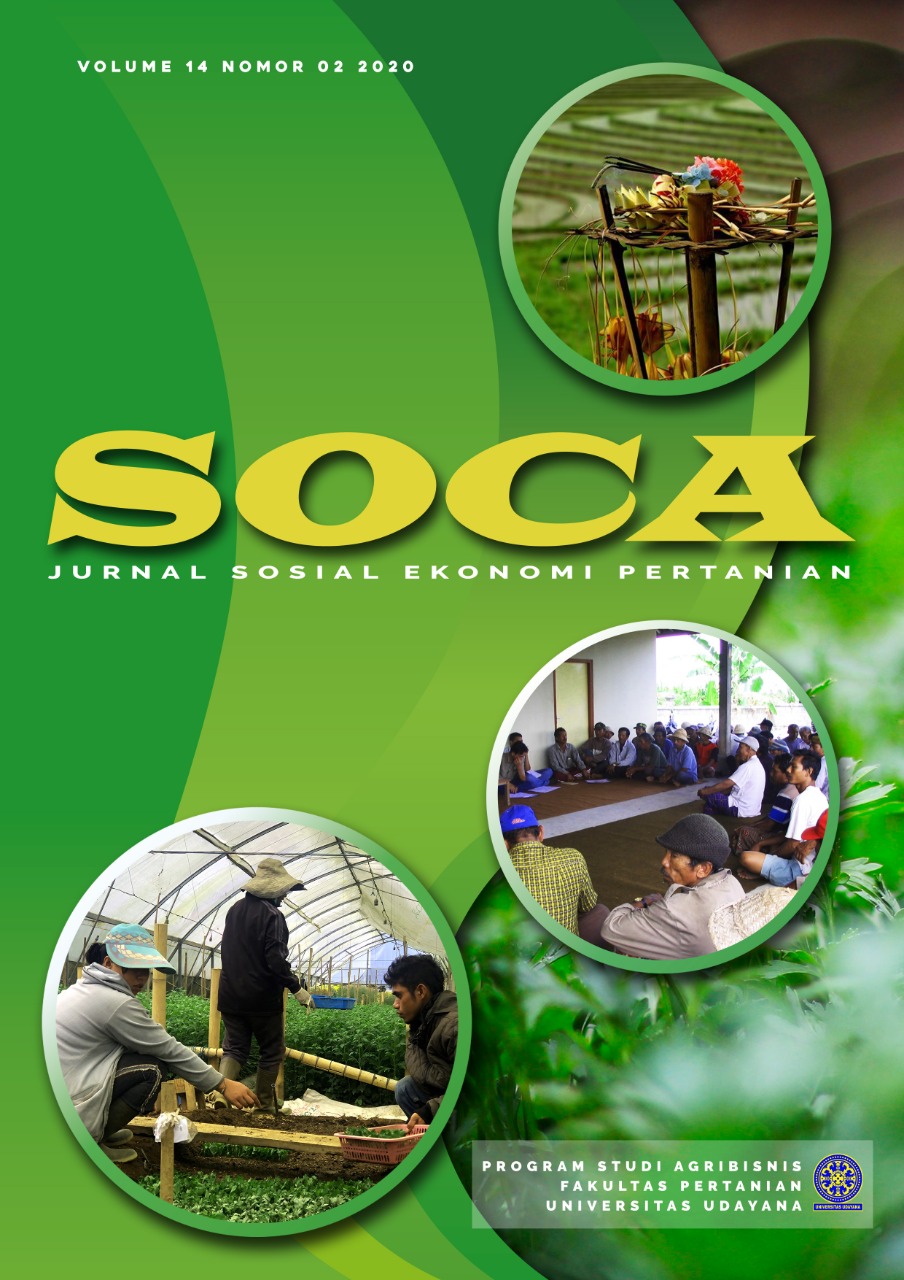Farmer Group Institution’s Typology and Agricultural Innovation Implementation Sustainability
Abstract
Farmer group institutions have been being a target group for various innovations in the agricultural development program. Unfortunately, the aspect of their institutional system is getting ignored frequently. This study aimed to know the farmer group institution performance’s determinant factors and its effect on the agricultural innovation implementation sustainability. This was a longitudinal study using a qualitative approach involving ten farmer group institutions (mixed crop-livestock farming) done in Lombok island. The study showed that farmer groups with a good institutional system relatively performed a high level of sustainable innovation implementation in comparison with the group with a poor institutional system. There were four key factors affected the performance and the farmer group institution’s achievement: (1) strong leadership; (2) transparency; (3) regular group meeting; (4) and cash generating factor. The study also showed that farmer group institution which didn’t have those key factors tended to use the farmer group institution only to complete their physical need (impounded cows for security reason). It rarely uses to empower its group members. These conditions slowly could be developed as an individualistic treat on each group member that prevents the sustainable innovation implementation in the future. The agricultural innovation on this type of group usually only implemented in a short amount of time. Therefore, guidance for a good institutional system in a farmer group institution is required to be conducted to achieve a sustainable and comprehensive agricultural innovation implementation. Some strategies could be used to develop the four key factors to form a good institutional system in the farmer group institution.
Downloads
References
Braun V, Clarke V. 2006. Using Thematic Analysis In Psychology. Qualitative Research in Psychology. 3(2): 77-101.
Bryman A. 2004. Social Research Methods. Second Edition. Oxford: Oxford Univeristy Press.
Chambers R. 1994. The Origin And Practice Of Participatory Rural Appraisal. World Development. 22(7): 953-969.
Dahlanuddin; Muzani A; Sutaryono YA; McDonald C. 2009. Strategi peningkatan produktivitas sapi Bali pada sistem kandang kompleks: pengalaman di Lombok Tengah, NTB. Paper presented at the Pengembangan Sapi Bali Berkelanjutan dalam Sistem Peternakan Rakyat, Mataram.
Dilts R. 1990. Researchers from The Village: An Indonesian Non-Government Rural Action And Community Development Program. Innotech Journal. 1: 34-42.
Hilmiati N, Sutartha, Panjaitan T. 2016. Managing Sustainable Practice Changes In A Low Input Bali Cattle Production System In West Sumbawa. International Journal of Sustainable Development. 9(1): 47-53.
Hoffmann V, Probst K, Christinck A. 2007. Farmers And Researchers: How Can Collaborative Advantages Be Created In Participatory Research And Technology Development? Agriculture and Human Values. 24(3): 355-368.
Korten F. 1983. Community Participation: A Management Perspective On Obstacles And Pptions. In David C. Korten and Felipe B. Alfonso (eds.) Bureaucracy and the Poor: Closing the Gap. Singapore: McGraw-Hill International Book Company. p. 181-200.
Mastika, I. M. 2002. Feeding strategies to improve the production performance and meat quality of Bali cattle (Bos sondaicus). ACIAR Proceedings, Strategies to Improve Bali Cattle in Eastern Indonesia. pp. 1013.
Millar J. 2009. Adapting Extension Approaches to Cultural Environments In South East Asia: Experiences Form Laos And Indonesia. Extension Farming Systems Journal. 5(1):143-148.
Millar J, Connell, J. 2010. Strategies for Scaling Out Impacts From Agricultural Systems Change: The Case Of Forages And Livestock Production in Laos. Agricultural Human Values. 27:213-225.
Ministry of Agriculture. 2005. Ministry of Agriculture Decree Number03/PERMENTAN/2005. Jakarta
Petheram RJ. 2000. Introduction And Review. In JR Petheram (Ed.) A Manual Of Tools For Participatory R&D In Dryland Cropping Areas (p. 1-15). Creswick: Rural Industries Research&Development Corporation.
Quarry W, Ramirez R. 2009. Communication For Another Development: Listening Before Telling. London: Zed Books.
Servaes J, Malikhao P. 2008. Development Communication: Approaches In An International Perspective. In J Servaes (Ed.), Communication for Development and Social Change (2 ed.). New Delhi: SAGE India.
Snapp S, Heong KL. 2003. Scaling Up And Out. In Pound P, Snapp S, McDougall C,. Braun AR (Eds.), Managing Natural Resources For Sustainable Livelihoods: Uniting Science, Participation (p. 67-83). London: Earthscan.
Talib, C., Entwistle, K., Siregar, A., Budiarti-Turner, S., Lindsay, D. 2002. Survey of population and production dynamics of Bali cattle and existing breeding programs in Indonesia. ACIAR Proceedings, Strategies to Improve Bali Cattle in Eastern Indonesia. pp. 3-9.
Van de Fliert E, Budi C, Hendayana R, Murray-Prior R. 2010. Pilot Roll-Out: Adaptive Research In Farmer's World. Extension Farming Systems Journal. 6(1): 63-71.
Yin RK. 2003. Case study research: design and methods. Third ed. Vol. 5. London: SAGE Publications.













